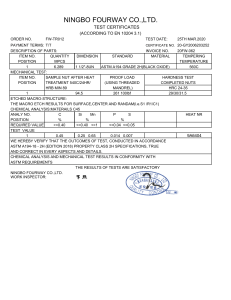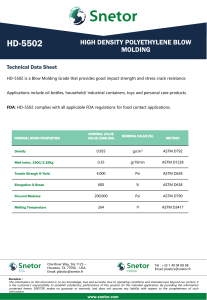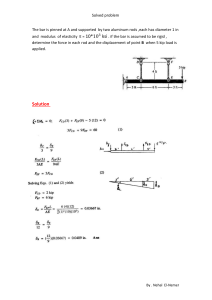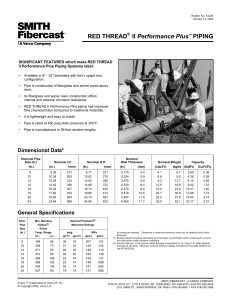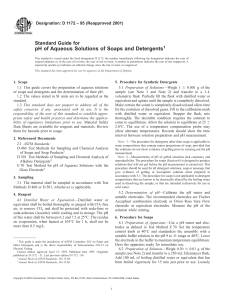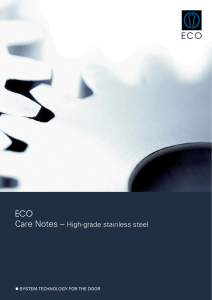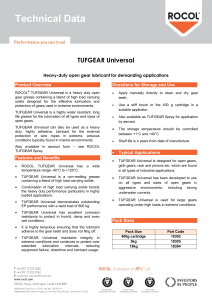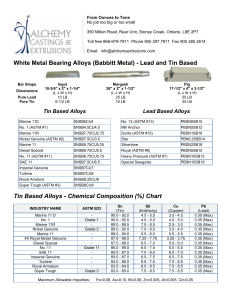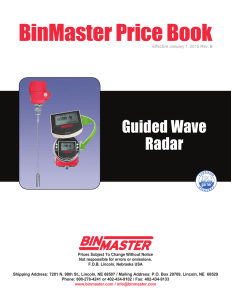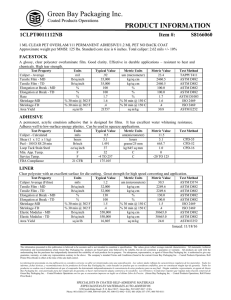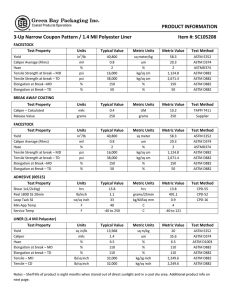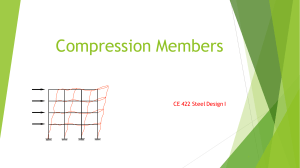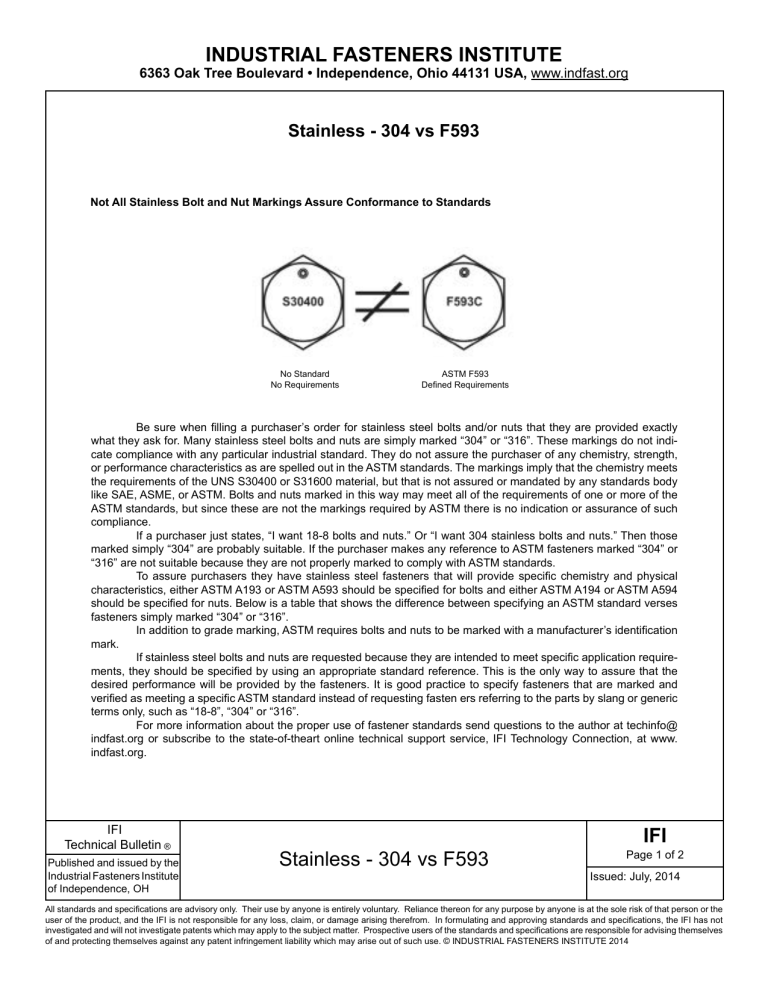
INDUSTRIAL FASTENERS INSTITUTE 6363 Oak Tree Boulevard • Independence, Ohio 44131 USA, www.indfast.org Stainless - 304 vs F593 Not All Stainless Bolt and Nut Markings Assure Conformance to Standards No Standard No Requirements ASTM F593 Defined Requirements Be sure when filling a purchaser’s order for stainless steel bolts and/or nuts that they are provided exactly what they ask for. Many stainless steel bolts and nuts are simply marked “304” or “316”. These markings do not indicate compliance with any particular industrial standard. They do not assure the purchaser of any chemistry, strength, or performance characteristics as are spelled out in the ASTM standards. The markings imply that the chemistry meets the requirements of the UNS S30400 or S31600 material, but that is not assured or mandated by any standards body like SAE, ASME, or ASTM. Bolts and nuts marked in this way may meet all of the requirements of one or more of the ASTM standards, but since these are not the markings required by ASTM there is no indication or assurance of such compliance. If a purchaser just states, “I want 18-8 bolts and nuts.” Or “I want 304 stainless bolts and nuts.” Then those marked simply “304” are probably suitable. If the purchaser makes any reference to ASTM fasteners marked “304” or “316” are not suitable because they are not properly marked to comply with ASTM standards. To assure purchasers they have stainless steel fasteners that will provide specific chemistry and physical characteristics, either ASTM A193 or ASTM A593 should be specified for bolts and either ASTM A194 or ASTM A594 should be specified for nuts. Below is a table that shows the difference between specifying an ASTM standard verses fasteners simply marked “304” or “316”. In addition to grade marking, ASTM requires bolts and nuts to be marked with a manufacturer’s identification mark. If stainless steel bolts and nuts are requested because they are intended to meet specific application requirements, they should be specified by using an appropriate standard reference. This is the only way to assure that the desired performance will be provided by the fasteners. It is good practice to specify fasteners that are marked and verified as meeting a specific ASTM standard instead of requesting fasten ers referring to the parts by slang or generic terms only, such as “18-8”, “304” or “316”. For more information about the proper use of fastener standards send questions to the author at techinfo@ indfast.org or subscribe to the state-of-theart online technical support service, IFI Technology Connection, at www. indfast.org. IFI Technical Bulletin ® Published and issued by the Industrial Fasteners Institute of Independence, OH Stainless - 304 vs F593 IFI Page 1 of 2 Issued: July, 2014 All standards and specifications are advisory only. Their use by anyone is entirely voluntary. Reliance thereon for any purpose by anyone is at the sole risk of that person or the user of the product, and the IFI is not responsible for any loss, claim, or damage arising therefrom. In formulating and approving standards and specifications, the IFI has not investigated and will not investigate patents which may apply to the subject matter. Prospective users of the standards and specifications are responsible for advising themselves of and protecting themselves against any patent infringement liability which may arise out of such use. © INDUSTRIAL FASTENERS INSTITUTE 2014 INDUSTRIAL FASTENERS INSTITUTE 6363 Oak Tree Boulevard • Independence, Ohio 44131 USA, www.indfast.org Bolts Marking Standard Chemistry Tensile Strength Yield Strength Hardness 304 None None None None None B8 ASTM A193 Type 304 stainless steel 75 ksi min. 30 ksi min. HRB 96 max. B8A ASTM A193 Type 304 stainless steel 75 ksi min. 30 ksi min. HRB 90 max. F593C ASTM F593 1/4 thru 5/8 Type 304 stainless steel 100 - 150 ksi 65 ksi min. HRB 90 - HRC 32 F593D ASTM F593 3/4 thru 1-1/2 Type 304 stainless steel 85 - 140 ksi 45 ksi min. HRB 85 - HRC 32 316 None None None None None B8M ASTM A193 Type 316 stainless steel 75 ksi min. 30 ksi min. HRB 96 max. B8MA ASTM A193 Type 316 stainless steel 75 ksi min. 30 ksi min. HRB 90 max. F593G ASTM F593 1/4 thru 5/8 Type 316 stainless steel 100 - 150 ksi 65 ksi min. HRB 90 - HRC 32 F593H ASTM F593 3/4 thru 1-1/2 Type 316 stainless steel 85 - 140 ksi 45 ksi min. HRB 85 - HRC 32 Nuts Marking Standard Chemistry Proof Load Hardness 304 None None None None 8 ASTM A194 Type 304 stainless steel Heavy Hex, 80 ksi Hex, 75 ksi HRB 60 - 105 8A ASTM A194 Type 304 stainless steel Heavy Hex, 80 ksi Hex, 75 ksi HRB 60 - 90 F594C ASTM F594 Type 304 stainless steel 100 ksi HRB 95 - HRC 32 F594D ASTM F594 Type 304 stainless steel 85 ksi HRB 80 - HRC 32 316 None None None None 8M ASTM A194 Type 316 stainless steel Heavy Hex, 80 ksi Hex, 75 ksi HRB 60 - 105 8MA ASTM A194 Type 316 stainless steel Heavy Hex, 80 ksi Hex, 75 ksi HRB 60 - 90 F594G ASTM A594 Type 316 stainless steel 100 ksi HRB 95 - HRC 32 F594H ASTM F594 Type 316 stainless steel 85 ksi HRB 80 - HRC 32 Disclaimer: All information provided in this document and/or presentation is based on data the Industrial Fasteners Institute believes to be reliable and accurate. Such information is intended for use by persons at their own discretion and risk. The information here in is based on industry standards and recognized practices. The Industrial Fasteners Institute and the representatives providing this material assume no responsibility for the content. IFI Technical Bulletin ® Published and issued by the Industrial Fasteners Institute of Independence, OH Stainless - 304 vs F593 IFI Page 2 of 2 Issued: July, 2014 All standards and specifications are advisory only. Their use by anyone is entirely voluntary. Reliance thereon for any purpose by anyone is at the sole risk of that person or the user of the product, and the IFI is not responsible for any loss, claim, or damage arising therefrom. In formulating and approving standards and specifications, the IFI has not investigated and will not investigate patents which may apply to the subject matter. Prospective users of the standards and specifications are responsible for advising themselves of and protecting themselves against any patent infringement liability which may arise out of such use. © INDUSTRIAL FASTENERS INSTITUTE 2014
